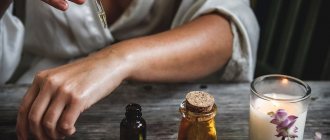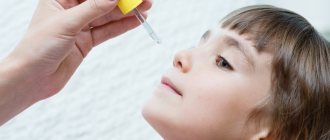How to treat folds in a newborn to avoid diaper rash
The sensitive, easily vulnerable skin of a newborn requires especially careful, systematic care.
Regurgitation during the day, milk flowing behind the neck, natural discharge, friction, stuck villi - provoke inflammation and diaper rash in the area of skin folds, sometimes very painful.
They often cause anxiety and crying of the baby. To avoid this, it is important for the mother to learn how to care for the skin and treat the baby’s folds.
Processing folds
To keep your baby's skin healthy, you need to bathe him daily, and in hot weather you can do this twice a day. When bathing a newborn, you should not overuse soap (it is optimal to use it once a week). It is better to replace baby soap with milder detergents.
After taking a bath, dry your baby's body with a soft towel or diaper, while avoiding friction, which can cause damage to the skin.
Then examine all folds for irritation, diaper rash, allergic reactions, powder and oil residues.
Examine the folds on the neck, as the most vulnerable place, pay attention to the place behind the ears, palms, fingers, elbows, armpits, legs, inguinal, buttock folds and the genitals of the newborn - redness often occurs there.
This is best done not only after an evening swim, but also in the morning.
After examination, treatment of the newborn’s folds is necessary, which can be done by various means:
- The folds are sprinkled with baby powder or, as our ancestors did, with starch.
- Lubricate with special oil, sold in children's stores and pharmacies. Boiled vegetable oil or Vaseline oil will also work;
- Many people use baby cream for preventive purposes.
What baby folds look like (Photo)
Preference should be given to what is most relevant to a specific problem.
For example, if the baby's skin is dry, you will need oil to moisturize it, and if the folds become wet, it is better to sprinkle them and dry them.
You should not use both oil and powder at the same time; this can provoke an inflammatory process, since when they are mixed, lumps are formed, which contribute to diaper rash and irritation.
- In order to treat the folds of a newborn with oil, you need to moisten a cotton pad and lubricate them sequentially from top to bottom. Pay special attention to your baby's neck, armpits and groin.
- For deep skin folds, it is best to use baby powder; the oil in this case can contribute to diaper rash.
- The cream is used when the child has pronounced dry skin, but in order to avoid diaper rash, it is not recommended to apply it directly to the folds. Cream and oil should not be applied directly to the baby’s skin, since a large amount of it can create a film on the surface of the body and negatively affect its condition. Mom must first apply a little cream to her hands, distribute between her palms and then treat the folds.
Air baths are necessary for the health of a newborn's skin. Do not rush to dress your baby immediately after bathing and treating the skin; give him time to lie down without clothes and a diaper.
What causes baby's skin problems?
The most common causes of skin problems:
- the rough fabric from which children's clothes or bedding are made causes abrasions on the skin;
- the baby was in a wet diaper for a long time;
- folds after bathing are poorly dried;
- the child is dressed very warmly for a walk, as a result he regularly sweats, this causes prickly heat;
- the material from which the diaper is made provokes allergic reactions.
What problems can occur on the skin of infants?
Oil, powder and baby cream are used to prevent skin diseases in a newborn; if they do occur, they need to be treated with other means.
Most often the baby is worried about:
- Miliaria is a small rash on the body. The cause is overheating. You can combat it by providing your baby with the necessary temperature conditions in the room, using clothes strictly according to the season;
- Diaper rash is severe redness of the skin (most often in the area of the buttocks, groin and armpits). The reason is undried skin after swimming, prolonged exposure to a humid environment. The solution is air baths, reducing the time you use a diaper, and drying the skin with special means. You can treat problem areas with Bepanten ointment, zinc ointment, Desitin. If the above measures do not help, then a drying powder with talc and zinc oxide will come in handy. As prescribed by the doctor, ultraviolet irradiation of problem areas is carried out;
- Fungal skin infections manifest themselves in stubbornly untreatable diaper rash. In this case, it is recommended to consult a doctor;
- Pyoderma is small superficial pustules caused by staphylococci and streptococci. To carry out adequate treatment, consultation with a specialist is necessary;
- Allergic dermatitis - manifests itself in the form of peeling, red spots, and rash. This disease is associated with the immaturity of the immune and enzyme systems of the newborn. For treatment, you need to contact an allergist.
Systematic care and careful treatment of the baby’s folds helps prevent diseases of the newborn’s delicate skin. It is known that child health problems, including skin problems, are easier to prevent than to treat.
source
How to treat folds in a newborn
A newborn baby is very vulnerable, its delicate skin is a real gateway for infection. In order for the baby to grow healthy and strong, parents must pay great attention to hygiene. One of the most important daily hygiene activities is the treatment of skin folds that every baby has.
Children in their first year of life have many folds on their skin.
Problem areas on a child's skin
Not all young parents know how to treat folds in a newborn. There are many effective remedies. First of all, the following areas need treatment:
- Armpits;
- In the groin area;
- Buttock area;
- Any areas where there is redness.
Proper toileting of the folds is of great importance for the well-being and mood of the baby. In newborns, the treatment of folds is a very important matter.
Causes of skin problems
Infants in the first year of life are at risk for a variety of skin problems, because at this age their immune system is not yet perfect, and any contamination can lead to infection. The most common causes of skin problems in infants under one year of age are:
- Improper implementation of hygiene measures;
- Failure to comply with daily hygiene rules;
- Parents’ ignorance of what to apply to the newborn’s folds;
- Poor nutrition of the child and the presence of a large number of allergens in his daily food;
- Constant wearing of synthetic clothing by the baby;
- Rare change of bed linen in a child's bed.
Pediatricians also say that infants very often have problems due to unsuitable disposable diapers. Diapers should fit well; They need to be changed as they become dirty, but at least 8-10 times a day.
From time to time, you need to give your baby the opportunity to spend a little time without a diaper; air baths are the best way to prevent diaper rash and any other skin diseases. It is also an important means of hardening the baby. It is best to carry out air baths before bathing, when the child is actively awake.
The approximate duration of the procedure is at least half an hour. In summer, during the waking period, you can replace diapers with disposable diapers.
Source: https://geraklionmed.ru/chem-obrabatyvat-skladochki-u-novorozhdennogo-chtoby-ne-bylo-oprelostey/
Diaper rash on a baby's skin: causes, treatment, prevention
Diaper rash in a newborn is redness on a baby's skin, which manifests itself when there is severe irritation of delicate areas of the body. The child feels a painful burning sensation, the skin becomes very red, and multiple pimples often appear.
If the problem of diaper rash is not resolved in time, it will develop into more serious consequences. Therefore, if you are faced with such a situation, we will tackle it right away!
Preventing its occurrence is not difficult at all. It is worth noticing even slight redness in time and carrying out simple preventive procedures.
Causes of diaper rash on the skin of a newborn
Diaper rash manifests itself mainly in areas of the skin that are more often exposed to temperature changes, moisture and friction, for example: the groin and intergluteal area, armpits, folds behind the ears and neck, lower abdomen.
Very often, diaper rash can appear on the bottom of newborns, since it is the bottom that often suffers temperature changes and the influence of bowel movements. Judge for yourself: a newborn is in diapers for a long time, while the bottom is not only hot, but also wet after emptying and, accordingly, a greenhouse effect occurs.
Not all mothers change the diaper right away, because it is intended for longer use. However, not all diapers can withstand the number of hours indicated on the package, and children are all different - the frequency of bowel movements is different for each baby.
The main causes of diaper rash:
- Bowel movements (urination). The delicate skin of a newborn, after frequent contact with urine and feces, turns red and can become very inflamed. Uric acid and fecal proteases, with prolonged contact with delicate skin, cause severe irritation and itching;
- Wet diaper. Not everyone can use expensive diapers that effectively absorb baby urine. It’s also not always possible to change a wet diaper on time. Due to prolonged exposure to a hot and wet diaper, the baby’s bottom appears as if in a greenhouse, which contributes to the appearance of diaper rash;
- Poor quality diaper. Sometimes a newborn may experience allergic reactions to a component of the absorbent base. In this case, diaper rash forms clearly in the diaper area;
- Insufficient care for the newborn. When caring for your baby, you should not forget about all the folds, make sure that the skin is not too dry, and also wipe the skin dry after bathing. If diaper rash is detected on the body of a newborn, take measures to eliminate the problem;
- Frequent friction. Make sure that the diaper is put on correctly and its folds are straightened, also pay attention to the comfort of the clothes, for example, it is better to remove the tags on the clothes of newborns immediately so that they do not rub the skin. Since irritated skin loses its protective properties, and over time, rashes and diaper rash appear on it;
- Nutrition for mother and baby. The food you eat while breastfeeding also affects the composition of your newborn's stool. Watch what you eat, correctly introduce new foods into your baby’s diet, this will help avoid an allergic reaction that can cause diaper rash. Read more in the course Safe nutrition for a nursing mother>>>
- Sweating. In case of incorrectly chosen clothes, as well as on particularly hot days, babies develop the so-called heat rash. If you do not treat it in time, diaper rash will occur.
Important! Diaper rash primarily occurs in areas of the skin that do not receive sufficient air. The presence of moisture promotes the active development of bacteria. Therefore, it is necessary not only to know how to avoid diaper rash in newborns, but also how best to treat it.
What types of diaper rash can appear on baby skin?
Diaper rash can appear on the following areas of the skin:
- butt;
- armpits;
- folds (arms, legs, neck, tummy);
- behind the ears.
Baby's butt
If you find redness in the diaper area, or, even worse, the redness has become bright, sprinkled with small pimples, you need to urgently get rid of this scourge. So, how to treat diaper rash on the bottom of newborns? In reality, not everything is so complicated; diaper rash can be cured in the first stages:
- Alternate between washing with water and cream. This will protect inflamed skin from drying out. Take rich baby cream, squeeze it onto a cotton pad and wipe your butt;
- Forget about soap, it further dries out the baby’s already defenseless skin;
- After bathing, gently dry your body with a soft towel, be extremely careful with areas of the skin where diaper rash has already appeared;
- Allow your baby to take air baths as often as possible. They are also necessary immediately after washing;
- Before putting on a diaper, use powder or special zinc-based creams. Zinc dries and also kills microbes that cause diaper rash;
- Make sure that the newborn does not have an allergic reaction to the diaper;
About caring for a newborn, proper bathing and how to make your motherhood simple and comfortable, see the online course “Happy Motherhood: Methods of Gentle Care” >>>
Armpits
These delicate areas can often suffer not only from the heat, but also from additional friction from clothing. To avoid diaper rash under the arms of a newborn, these simple rules will help:
- Make sure your newborn's clothes are comfortable enough. It is better to wear it up with sleeves, avoiding T-shirts and sleeveless bodysuits;
- In hot weather, have wet wipes with you that you can use to wipe your skin; Read about how often you can use wet wipes in the article: Wet wipes for newborns>>>
- Bathe your baby daily or as needed, the main thing is not to use soap often;
- As a preventative measure, you can add string or chamomile to bathing water; You can learn about what other herbs are useful in the article Herbs for bathing a newborn>>>
- Always have zinc-based cream or powder with you.
folds
A healthy newborn should have a certain number of folds on the legs, arms, and neck. But you, as a loving mother, need to remember to take care of these folds. By regurgitating food, the baby gets his neck dirty, moisture gets into the fold and gets pinched. Lack of proper hygiene can cause redness and diaper rash. The procedure for caring for folds is extremely simple:
- Check all the baby’s folds daily (wipe and, if necessary, apply baby cream);
- Monitor the temperature, do not let the baby overheat;
- If you notice severe redness in the folds, bathe your baby and apply a zinc-based cream.
Behind the ear
Not all mothers remember the place behind the ear, but you and I know that this is where dust, dirt and moisture also accumulate. The skin in this area is also delicate and prone to irritation. When performing hygiene procedures, try not to forget to also look behind the ear. If diaper rash appears behind the ear of a newborn, rinse the skin with water, dry it and apply a special cream.
How and with what to treat diaper rash
To quickly get rid of diaper rash, the newborn should be without a diaper for as long as possible.
If this is not possible, you should try to change the diaper as often as possible.
Make sure your butt is not dirty or wet.
But in our time, choosing what to treat diaper rash in newborns is not at all difficult.
Let's go over the most common medications used for diaper rash:
- Powder (talc). The simplest, most inexpensive, and not very convenient means. Talc dries out the skin, the newborn feels relieved, and the mother is happy. But you need to make sure that the talc does not roll up in the folds, otherwise it will only cause harm. As a mother of three children, I can say that I have never used talcum powder. When there are creams in tubes that are convenient to apply, I chose them;
- Bepanthen ointment. Usually every mother has this cream, which is recommended by most obstetricians and pediatricians.
Bepanten contains vitamin B5, which regenerates the skin, accelerating mitosis, and also improves the elasticity of collagen fibers. Thanks to this, skin irritation goes away quickly.
But the ointment is quite greasy and viscous. In general, as a mother, I would find him unpleasant. Maybe you'll like it. See the article about Bepanten cream>>>
- Cream Sanson. Just like the previous drug, Sanson does its job well. It should be applied to problem skin, as well as in folds and behind the ears. It is necessary to use the cream for five days until the redness subsides;
- Ointment for diaper rash in newborns Desitin. Thanks to its properly selected composition, Desitin cream has a number of actions:
- antifungal and protective effect;
- anti-inflammatory and regenerating effect;
- absorption (absorption of excess moisture, fat, sweat).
- Folk remedies. Sea buckthorn oil has a very good healing effect, but you need to keep in mind that it is very easily soiled. Before applying it, it is necessary to eliminate the main problem - the fungus. To combat the fungus, bathing a newborn in a collection of herbs (calendula, string, oak bark) is suitable. It is much easier to buy one of the above creams or zinc paste and apply it to the damaged area of the skin.
Watch also my short video tutorial about diaper rash in babies:
Prevention of diaper rash in a newborn
In reality, diaper rash is an advanced condition of inflamed skin, so your main task is to get rid of diaper rash and prevent irritation from occurring on the skin again. For this purpose, prevention of diaper rash is carried out. It is enough to adhere to the following measures:
- Consider the temperature. Make sure your child does not overheat or freeze. More information about the temperature in the room for a newborn>>>;
- Try to dress your newborn in natural fabrics, avoiding synthetics;
- Wash your baby's clothes only with baby powder, watch the skin reaction;
- Treat all areas of your newborn's skin correctly. For any redness, apply a zinc-based cream to clean skin to avoid diaper rash;
- When walking outside, carry wet wipes with you;
- Allow your baby to lie naked as much as possible while taking air baths. This will help avoid the appearance of fungus on the skin, and therefore diaper rash will not occur.
Pay as much attention as possible to your baby: watch the skin, add a herbal decoction to the baby’s bath once a week, take action for any minor redness and diaper rash will not appear on the newborn’s skin.
Source: https://uroki4mam.ru/oprelosti-u-novorozhdennogo
Diaper rash in newborns: how to treat and how to avoid them - says pediatrician
The arrival of a baby in a family is a very important event. Young parents for whom this is their first experience should prepare themselves.
The subtleties of caring for a baby’s delicate skin and many aspects of hygiene are discussed in schools for young mothers in the form of lectures; Internet resources allow you to learn a lot of new things about this topic.
But every mother has encountered such a problem as diaper rash in a newborn, and many cannot cope with the situation, despite the abundance of information. On the contrary, the flow of knowledge often makes it difficult to choose clear tactics that will be effective and simple.
Today we will talk about how to avoid diaper rash in newborns and how to treat it if it suddenly occurs.
Peculiarities of the skin in children in the first months of life
When a baby is born, its skin has a bright red tint. This is due to the saturation of the blood with oxygen, a change in the gas composition of the blood. The baby's skin is so delicate that it can be injured even from rough seams on rompers or undershirts.
The epidermis layer is quite loose. The epidermis and dermis do not have clear boundaries, so they can easily peel off with the appearance of blisters.
The skin of a newborn contains up to 80% water compared to an adult, whose moisture content is about 60%.
The baby's skin is thinner, more elastic, and has a tendency to peel.
It should also be remembered that the sweat glands do not function sufficiently. A baby in the first month of life can easily overheat.
Causes of diaper rash
Most often, diaper rash occurs in newborns and children in the first year of life for the following reasons:
- poor quality diaper;
- staying in a diaper for a long time;
- lack of daily water procedures;
- intolerance to the powder used to wash children's clothes;
- tendency to allergic reactions;
- improper nutrition of the mother while breastfeeding, which can lead to frequent bowel movements;
- a change in the pH of feces towards a more acidic side, which leads to even greater irritation of the skin.
Favorite places for diaper rash are the natural folds of the skin (groin, buttocks, armpits), less often - the folds behind the ears, the lower abdomen. Mostly diaper rash occurs in the groin and butt.
Try to use the diaper only during walks, trips to the children's clinic, or at night. And during the day, when the baby is at home, you can use knitted diapers sewn in the shape of triangles. Of course, this will complicate washing, but your baby’s skin will be healthy.
Pediatricians, together with dermatologists, conventionally distinguish three degrees of diaper rash.
- The first degree is redness of the skin. The very beginning, a “bell” that the baby’s skin is subject to excessive friction due to improper care.
- Second degree. The redness becomes more pronounced, cracks and weeping appear.
- Further, if the mother does not provide any help to the baby, the third stage occurs - the stage of pronounced cracks in the skin, the addition of a bacterial infection (the appearance of pustules), or a fungal infection. At this level, pain and itching will occur. The child will be extremely restless, will not be able to sleep, and may even refuse to eat.
Types of diaper rash:
- diaper, or contact, dermatitis;
- impetigo;
- eczema and other types of allergic reactions.
Contact dermatitis
As the name suggests, this type of diaper rash is associated with the appearance of rashes and crusts on the skin upon contact with diapers and clothing. Most often, it can be caused by poor-quality material from which children's clothes are made.
Use only baby powders for washing diapers and baby undershirts. The most common brand, “Eared Nanny,” has proven hypoallergenic properties.
Impetigo is a disease of infectious etiology, primarily caused by poor hygiene. Can affect any age category. The infection is bacteria, staphylococcus or streptococcus. A small baby can become infected in the maternity hospital from the staff or from a relative.
Some literary sources describe that impetigo blisters can grow to the size of a cherry, but this has not been observed, since due to their thinness they quickly burst.
Symptoms appear in the first days of life. Bubbles filled with liquid appear on the skin. Then they burst and leave behind erosion, which is successfully cured without leaving scars or ulcers.
If impetigo is detected in a newborn in the maternity hospital, it must be isolated until the source of infection (the patient or the carrier) is identified.
The favorite place for impetigo is the groin area. But it can also occur in other natural folds of the baby.
- Hospitalization of mother and newborn in the hospital (infectious diseases department).
- Avoid contact of moisture with affected areas of the skin.
- The child should only have his own clean, ironed diapers.
- Try to avoid unnecessary contact with the child. To avoid infection, mother should wear gloves.
You cannot squeeze out the bubbles yourself. This is fraught with aggravation of the condition, up to the occurrence of septic shock.
The blisters must be treated with an antiseptic (aniline dyes, zinc-based ointments). The whole task of treating impetigo comes down to ensuring that the blisters dry out and disappear as quickly as possible.
The use of oral antibacterial therapy is possible only by the doctor’s decision if the child’s well-being worsens or if blood test results are poor.
Is a diaper a helper or a pest in the modern world?
Of course, the world does not stand still. The advent of diapers made my mother's life much easier. But let's discuss some simple rules for using this device.
- Try to purchase diapers from well-known brands such as Pampers and Hagis in pharmacies, which have a quality mark and proven hypoallergenicity.
- The diaper is a disposable product. There is no need to dry it on the battery and put it on again.
- Also, you should not wait until it becomes full and weighs more than the baby itself. Keeping a baby in a diaper for more than 2 hours is not recommended.
- It is better to wear a diaper only when going for a walk, going to the clinic, or when the child sleeps at night. It should be changed at night.
- After removing the diaper, wash the baby and let him “swim” in the air bath for 15 minutes.
Treatment of diaper rash in newborns
A pediatrician will be able to answer your question about how to deal with the hated diaper rash in newborns.
- When the stage of redness occurs, treating diaper rash on the bottom of newborns can only be done by adjusting hygiene. Diapers should be changed frequently and the baby should not be left wet. Be sure to wash your baby after every diaper change. After bathing, leave your baby naked for 5-10 minutes so that the folds dry thoroughly. Then you need to treat it with baby diaper cream and swaddle it.;
- If the second stage of diaper rash occurs, creams will help. There are many skin care products for newborns in pharmacies.
Let's look at some of them.
- Ointments and creams containing zinc oxide and talc. They dry out the skin during the second stage of diaper rash, when it becomes wet. Here are some of them - zinc ointment, Desitin, zinc oxide-based talkers.
- Cream or ointment Bepanten, its analogues - Dexapanthenol, Panthenol. This drug restores damaged skin areas and has a weak analgesic effect.
- Clotrimazole is an antifungal drug that helps with candidal infections.
In case of diaper rash with crusts, you should not bathe the baby; you should only wash it in a weak solution of potassium permanganate, and then dry it well with a towel. If pustules appear, they can be treated with brilliant green.
- if diaper rash with crusts and pustules occurs, it is better to stop using diapers;
- if you need to fight diaper rash with an allergic component in newborns, antihistamines will help - Zodak, Suprastin. It is also possible to change baby powder and brand of diapers.
Says Dr. Komarovsky: “Many parents believe that if diaper rash appears, you can apply cream a couple of times, and everything will go away. In fact, diaper rash is different. If the surface gets wet, then it is necessary to dry it with a zinc-based mash. Baby cream can only help us at the initial stage of diaper rash or as a preventive measure. If a bacterial infection occurs, then antibiotic ointments are used. For allergic reactions with a pronounced exudative component, it is possible to use ointments with anti-inflammatory hormones.”
To summarize the above, it can be noted that prevention is better than treatment.
Here are some tips.
- You can bathe your baby every day in herbs such as chamomile and chamomile.
- Change diapers regularly.
- Avoid staying in a diaper for a long time.
- Adjust the mother's diet if the baby is breastfed.
- Use air baths after bathing.
Love, care and proper care are all that is needed for the delicate skin of a newborn.
https://www.youtube.com/watch?v=fkXouU3wevo
Article rating:
(3 5,00 of 5) Loading...
Source: https://kroha.info/uhod/oprelosti-u-novorozhdennyh
How to make oil for a newborn baby
Caring for the delicate skin of a newborn is one of the main tasks of young parents. The fact is that due to the thinness of the skin, air exchange occurs in the baby’s body, and how clean and moisturized the baby’s skin is significantly affects this process. The protective properties of the skin during the newborn period are very weak and require constant assistance in case of damage in the form of peeling and inflammation. The child’s skin must not only be cleansed and nourished, but also an additional layer must be artificially created that will protect the dermis from diaper rash and microorganisms.
One of the frequently recommended skin care products for newborns is sterile oil. It is used to prevent the appearance of diaper rash, helps to effectively remove serum lubricant in the folds of the skin and perineum, and is used for massage and treatment of the scalp and child’s body after bathing. Vegetable oils have high biological activity, are natural antioxidants, and contain vitamins and fatty acids. The lighter the structure of the oil, the better for the baby’s skin, so pediatricians do not recommend frequently using synthetic oils (paraffin, petroleum jelly), and “heavy” vegetable oils are asked to be used sparingly.
From the author:
Oil for baby skin care should definitely be in a mother’s arsenal. It really helps to cope with crusts on the head and behind the ears, and helps with dry skin and slight redness. For my child, I took baby oil with calendula, sea buckthorn and cedar extract, which is intended for massage. Since there was little birth lubricant on the child’s body, I did not treat the folds with oil, but it was ideal for the crusts on the head and behind the ears. Now I understand that it was worth, firstly, limiting myself to a small bottle, and secondly, finding an oil without fragrances, since my daughter did experience slight redness after the next contact with the oil. I think that with my next child I will use more natural oil options.
In stores and pharmacies today there is a huge assortment of oils, most of which contain fragrance, additional components or flavors. Despite all the assurances from the manufacturers, such oils can still cause allergies in a newborn, so it is safer to prepare the oil for treating the baby yourself. How to do this will be described below.
How to prepare sterile oil at home ↑
Since the oil will be needed from the first days of the baby’s life, it should be prepared during pregnancy. So, to prepare oil for processing a newborn, you will need good extra virgin olive oil. You can also use unrefined sunflower oil, although it is considered coarse. In addition, containers are needed - small glass bottles or jars with a lid, which should be pre-sterilized. The selected oil must pass a quality test. To do this, pour it into a glass and leave for 30 minutes in a dark place. If during this time a sediment has formed in the oil, it can be used. If flakes occur, it is better to abstain.
Sterile oil is prepared in a water bath. The starting material is poured into a small open container, which is placed in a pan with slightly heated water. The water should be slightly higher than the level at which the oil is poured in the jar. After the water boils in the pan, you should wait about 5-7 minutes, constantly stirring the oil with a wooden stick to warm it up better. This time will be enough for the oil to become sterile. The product should be stored in a dark place.
How to use sterile oil for treating a newborn ↑
Sterile oil is used:
- to cleanse the nasal passages;
- for the treatment of ears;
- for lubricating flaky baby skin;
- to remove generic lubricant;
- for treating diaper rash with mild redness.
The baby’s nose is cleaned with cotton wool soaked in oil, the ears are treated only from the outside using cotton wool with oil, and birth lubricant, flaking on the skin and milky crusts on the head are removed with oiled cotton pads.
kidbe.ru
Treatment of folds for a newborn: what to lubricate and wipe the skin with, what oil
A newborn baby is very vulnerable, its delicate skin is a real gateway for infection. In order for the baby to grow healthy and strong, parents must pay great attention to hygiene. One of the most important daily hygiene activities is the treatment of skin folds that every baby has.
Children in their first year of life have many folds on their skin.
Why process folds?
Daily hygiene of a newborn - procedures
Parents often do not know how to smear the folds of a newborn and why it should be done at all. However, the importance of this daily hygiene procedure cannot be underestimated. It is necessary to treat problem areas in order to:
- Avoid diaper rash;
- Do not allow the delicate baby skin to dry out;
- Notice in time the onset of an allergic reaction or any irritation;
- Clean the baby's skin from dirt and sweat.
Usually, breastfed or bottle-fed infants tolerate this procedure well.
Diaper rash
If diaper rash occurs, you can consult your pediatrician. He will tell you how to lubricate the folds of newborns when this problem occurs. Diaper rash usually appears if the skin does not breathe for a long time (for example, the baby’s diaper has not been changed for a long time). This leads to redness of the skin folds and causes the baby to feel severe discomfort.
Overdrying
In winter and autumn, when steam heating batteries operate at home, the air in city apartments can be very dry. This leads to drying out of the baby's skin.
Dry skin can crack, and various infections can easily enter the body through microcracks. Treating folds with a moisturizer will help quickly cope with this problem and improve the protective functions of the baby’s skin.
As moisturizers, you can use a variety of oils and creams intended for babies in their first year of life.
Moisturizers will help prevent dryness
What can you use to lubricate folds?
How to wash a newborn - tips for parents
To perform your daily toilet, you can use a variety of cosmetics, for example:
- Moisturizing oils;
- Powders;
- Creams.
For newborns, processing clutches will not take much time if everything is done according to the rules. Any product should be used in strict accordance with the instructions attached to it. It is strictly forbidden to use cosmetics intended for children over one year old - they are not suitable for the delicate skin of infants.
Oil
Parents and children's doctors often argue about which oil to wipe the folds of a newborn. There are many products on sale that vary in price and composition. Natural oils based on plant components create a thin protective film on children's skin, protecting it from the penetration of dangerous pathogens.
Cream
If parents don’t know what to use to wipe the newborn’s folds, you can choose the good old baby cream. It has a good moisturizing effect and protects vulnerable areas from drying out, irritation, and redness. You should not buy expensive creams, since their action is similar to that of the domestic “Children’s” cream.
Powder
When asked how to treat a newborn’s skin, many pediatricians answer that the best remedy is talcum powder. It absorbs moisture well, rolling into lumps, and does not cause allergic reactions. This product is suitable for daily use. You can use the powder several times a day, every time you change a disposable diaper.
Powder should be chosen without fragrances or artificial flavors. These components in the composition significantly increase the cost of the cosmetic product and can cause severe allergic reactions in the baby. Lumps of powder remaining on the baby's skin should be carefully removed with a napkin so that they do not cause discomfort to the baby.
How to treat wrinkles after bathing
According to Komarovsky, a child under one year old should bathe daily. After bathing, toileting the skin, including the perineum and buttocks, is mandatory. The child is taken out of the bath, dried and the skin is carefully examined. The folds are carefully blotted and treated with any suitable means.
After the bath, just pat the baby dry with a towel, no need to rub too hard
To treat the skin, you can use any baby oils. Johnson's baby oil gives good results. After the hygiene procedure, the same product can be used for massage.
When asked what is the best way to lubricate the folds of newborns, grandmothers often answer that there are many folk remedies for treating the skin without the use of industrially produced preparations.
However, any folk remedies should be used only after consultation with a pediatrician.
You should not use boiled vegetable oil for hygiene procedures, as it is unsterile and does not have a beneficial effect on the skin.
How to properly wipe the folds of a newborn
You need to perform hygiene procedures and care for your baby correctly. The folds are carefully blotted, the main thing is not to rub them so as not to cause irritation. At the end, excess cosmetic product is removed with a napkin or cotton pad.
Groin area
The folds in the groin area are carefully straightened, then carefully blotted and a small amount of cream or oil is applied. After this, the baby needs to spend a little time without a disposable diaper - take an air bath.
Attention! It is necessary to examine the groin area of boys and girls after each change of a disposable diaper. Diaper rash is especially common in this area because the skin under the diaper can sweat a lot.
Neck
To clean the neck folds, you need to carefully lift the baby’s chin and wipe the skin where it is wrinkled. If the baby is stubborn and does not want to raise his head, you can do it together: one person gently holds the baby’s head, the second person processes each skin fold and cleans the neck.
Other
Any other problem areas are carefully wiped with a cotton pad soaked in the product. The powder is carefully poured from the tube, spreading over the surface of the skin in an even, even layer. After lubrication, excess is removed (no need to wipe with a towel), and the child is put on new clean clothes (or swaddled).
The treatment should be carried out after discharge from the hospital every day, morning and evening, as well as after each diaper change for the baby.
If you do not neglect these basic rules, you can avoid serious skin diseases: eczema, diaper rash, irritation.
For processing, you need to choose only those products that are intended for children in the first year of life - they do not contain preservatives and other harmful substances that are often present in adult cosmetics.
Source: https://kpoxa.info/uxod-razvitie/chem-obrabatyvat-skladochki-novorozhdennogo.html
Newborn babies do not need to be lubricated with sunflower oil
Pons
olive oil is “for babies.”
Using olive or sunflower oil when caring for newborns destroys the protective skin barrier that prevents drying and blocks allergens and infections. This is reported by researchers from the University of Manchester (UK).
Despite the fact that most obstetricians recommend using olive or sunflower oil to care for dry skin (as they were taught at the institute), there is little work analyzing the effects of these oils; so far, only small laboratory studies have been carried out.
The lack of interest in the effects of oils on children's skin is difficult to explain, especially when you remember that the incidence of eczema in the UK has risen sharply in recent decades - from 5% of children aged 2 to 15 in the 1940s to around 30% now .
To test the effects of the two oils on the skin of babies, doctors at Saint Mary's Hospital in Manchester selected 115 newborn babies who were divided into three groups. Children in each group were cared for using different products - olive oil, sunflower oil and no oil at all - the control group.
After 28 days, during which the children of the two groups received a few drops of oil on their skin twice a day, the lipid lamellae in the skin structure of each child were studied. The development of skin barrier function in children in the oil-treated groups was delayed compared to children in the control group.
Alison Cooke, lead author of the study, explains:
“If you imagine the protective function of the skin as a brick wall, where the bricks are cells, then lipid lamellae are the solution that holds it together. If it is not strong enough, then cracks appear that allow water and foreign bodies to penetrate inside.
"The oil slows down the creation of this 'mortar' and this may be linked to the development of conditions such as eczema."
Infants' skin treated with oil is well hydrated, but the researchers believe that since the effects on the lipid layer are not entirely clear, the benefits do not outweigh the possible harm.
There are no national guidelines for newborn skin care in the UK. Research from South Asia suggests that sunflower oil has antimicrobial effects that may benefit premature babies in developing countries.
But sunflower or olive oil should not be used to care for healthy babies in a developed country, scientists conclude.
Alison added:
“We need to do more work on this issue, testing different oils, and examining the possible link between their use and eczema, but it is already clear that current parental counseling is not based on any evidence for the use of these two oils in newborn skin care. should be avoided."










